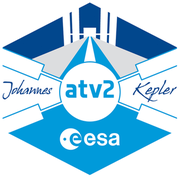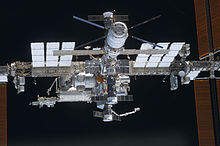
The International Space Station (ISS) is a large space station that was assembled and is maintained in low Earth orbit by a collaboration of five space agencies and their contractors: NASA, Roscosmos (Russia), ESA (Europe), JAXA (Japan), and CSA (Canada). The ISS is the largest space station ever built. Its primary purpose is to perform microgravity and space environment experiments.

The Progress is a Russian expendable cargo spacecraft. Its purpose is to deliver the supplies needed to sustain a human presence in orbit. While it does not carry a crew, it can be boarded by astronauts when docked to a space station, hence it is classified as crewed by its manufacturer. Progress is derived from the crewed Soyuz spacecraft and launches on the same launch vehicle, a Soyuz rocket.

The Automated Transfer Vehicle, originally Ariane Transfer Vehicle or ATV, was an expendable cargo spacecraft developed by the European Space Agency (ESA), used for space cargo transport in 2008–2015. The ATV design was launched to orbit five times, exclusively by the Ariane 5 heavy-lift launch vehicle. It effectively was a larger European counterpart to the Russian Progress cargo spacecraft for carrying upmass to a single destination—the International Space Station (ISS)—but with three times the capacity.

Uncrewed spaceflights to the International Space Station (ISS) are made primarily to deliver cargo, however several Russian modules have also docked to the outpost following uncrewed launches. Resupply missions typically use the Russian Progress spacecraft, European Automated Transfer Vehicles, Japanese Kounotori vehicles, and the American Dragon and Cygnus spacecraft. The primary docking system for Progress spacecraft is the automated Kurs system, with the manual TORU system as a backup. ATVs also use Kurs, however they are not equipped with TORU. The other spacecraft — the Japanese HTV, the SpaceX Dragon and the Northrop Grumman Cygnus — rendezvous with the station before being grappled using Canadarm2 and berthed at the nadir port of the Harmony or Unity module for one to two months. Progress, Cygnus and ATV can remain docked for up to six months. Under CRS phase 2, Cargo Dragon docks autonomously at IDA-2 or 3 as the case may be. As of December 2022, Progress spacecraft have flown most of the uncrewed missions to the ISS.

A space rendezvous is a set of orbital maneuvers during which two spacecraft, one of which is often a space station, arrive at the same orbit and approach to a very close distance. Rendezvous requires a precise match of the orbital velocities and position vectors of the two spacecraft, allowing them to remain at a constant distance through orbital station-keeping. Rendezvous may or may not be followed by docking or berthing, procedures which bring the spacecraft into physical contact and create a link between them.

Major Paolo Angelo Nespoli is an Italian astronaut and engineer of the European Space Agency (ESA). In 2007, he first traveled into space aboard the Space Shuttle Discovery as a mission specialist of STS-120. In December 2010 he again traveled into space aboard the Soyuz TMA-20 spacecraft as an Expedition 26/27 flight engineer. Nespoli's third spaceflight was on board Soyuz MS-05, which launched in July 2017 for Expedition 52/53. He was also the European Space Agency's oldest active astronaut prior to his retirement in 2019.

Rassvet , also known as the Mini-Research Module 1 and formerly known as the Docking Cargo Module, is a component of the International Space Station (ISS). The module's design is similar to the Mir Docking Module launched on STS-74 in 1995. Rassvet is primarily used for cargo storage and as a docking port for visiting spacecraft. It was flown to the ISS aboard Space ShuttleAtlantis on the STS-132 mission on 14 May 2010, and was connected to the ISS on 18 May 2010. The hatch connecting Rassvet with the ISS was first opened on 20 May 2010. On 28 June 2010, the Soyuz TMA-19 spacecraft performed the first docking with the module.
A parking orbit is a temporary orbit used during the launch of a spacecraft. A launch vehicle follows a trajectory to the parking orbit, then coasts for a while, then engines fire again to enter the final desired trajectory.

The Jules Verne ATV, or Automated Transfer Vehicle 1 (ATV-1), was a robotic cargo spacecraft launched by the European Space Agency (ESA). The ATV was named after the 19th-century French science-fiction author Jules Verne. It was launched on 9 March 2008 on a mission to supply the International Space Station (ISS) with propellant, water, air, and dry cargo. Jules Verne was the first of five Automated Transfer Vehicle spacecraft to be launched.

Expedition 26 was the 26th long-duration mission to the International Space Station. The expedition's first three crew members – one US astronaut and two Russian cosmonauts – arrived at the station on board Soyuz TMA-01M on 10 October 2010. Expedition 26 officially began the following month on 26 November, when half of the crew of the previous mission, Expedition 25, returned to Earth on board Soyuz TMA-19. The rest of the Expedition 26 crew – one US astronaut, one Russian cosmonaut and one ESA astronaut – joined the trio already on board when their spacecraft, Soyuz TMA-20, docked with the station on 17 December 2010.

Expedition 28 was the 28th long-duration expedition to the International Space Station, and began on 23 May 2011 with the departure of the members of Expedition 27. The first three members of Expedition 28 arrived on the ISS aboard the Soyuz TMA-21 spacecraft on 4 April 2011, and were joined on 9 June 2011 by the three other crew members, who arrived aboard Soyuz TMA-02M. The expedition saw a number of significant events, including the final Space Shuttle mission, STS-135, which took place in July 2011. Expedition 28 was superseded by Expedition 29 on 16 September 2011.
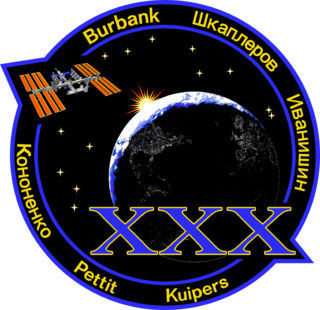
Expedition 30 was the 30th long-duration mission to the International Space Station (ISS). The expedition's first three crew members – Dan Burbank, Anton Shkaplerov and Anatoli Ivanishin – arrived on the ISS aboard Soyuz TMA-22 on 16 November 2011, during the last phase of Expedition 29. Expedition 30 formally began on 21 November 2011, with the departure from the ISS of the Soyuz TMA-02M spacecraft. The expedition ended on 27 April 2012, as Burbank, Shkaplerov and Ivanishin departed from the ISS aboard Soyuz TMA-22, marking the beginning of Expedition 31.

Kounotori 2, also known as HTV-2, was launched in January 2011 and was the second flight of the Japanese H-II Transfer Vehicle to resupply the International Space Station (ISS). It was launched by the H-IIB Launch Vehicle No. 2 manufactured by Mitsubishi Heavy Industries (MHI) and JAXA. After the supplies were unloaded, Kounotori 2 was loaded with waste material from ISS, including used experiment equipment and used clothes. Kounotori 2 was then unberthed and separated from the ISS and burned up upon reentering the atmosphere on 30 March 2011.
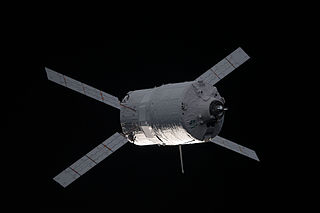
The Edoardo Amaldi ATV, or Automated Transfer Vehicle 003 (ATV-003), was a European uncrewed cargo spacecraft, named after the 20th-century Italian physicist Edoardo Amaldi. The spacecraft was launched by the European Space Agency (ESA) on 23 March 2012, on a mission to supply the International Space Station (ISS) with propellant, water, oxygen, and dry cargo.

Progress M-07M, identified by NASA as Progress 39P, is a Progress spacecraft which was used to resupply the International Space Station. It was the seventh Progress-M 11F615A60 spacecraft to be launched, the fourth for the year 2010 and has the serial number 407. The spacecraft was manufactured by RKK Energia, and is being operated by the Russian Federal Space Agency. It arrived at the space station whilst the Expedition 24 crew was aboard, and will remain docked for the entirety of Expedition 25, before departing during Expedition 26.
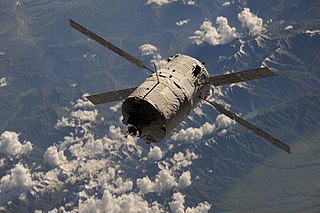
The Albert Einstein ATV, or Automated Transfer Vehicle 004 (ATV-004), was a European uncrewed cargo resupply spacecraft, named after the German-born physicist Albert Einstein. It was built to supply the International Space Station (ISS) with propellant, water, air, and dry cargo, and also to reboost the station's altitude with its thrusters. It was the fourth and penultimate ATV to be built, following the Edoardo Amaldi, which was launched in March 2012. Albert Einstein's components were constructed in Turin, Italy, and Bremen, Germany, and underwent final assembly and testing in Bremen in 2012. The spacecraft left Bremen for Kourou on 31 August 2012 to begin launch preparations.

A Reentry Breakup Recorder (REBR) is a device that is designed to be placed aboard a spacecraft to record pertinent data when the spacecraft (intentionally) breaks up as it re-enters Earth's atmosphere.

The Georges Lemaître ATV, or Automated Transfer Vehicle 5 (ATV-5), was a European uncrewed cargo spacecraft, named after the Belgian astronomer Georges Lemaître. The spacecraft was launched during the night of 29 July 2014, on a mission to supply the International Space Station (ISS) with propellant, water, air, and dry cargo. It was the fifth and final ATV to be built and launched. Georges Lemaître was constructed in Turin, Italy, and Bremen, Germany. Cargo loading was completed in Guiana Space Center on 23 July 2014.

A number of different spacecraft have been used to carry cargo to and from space stations. This list does not include crewed spacecraft.

The European contribution to the International Space Station comes from 10 members of the European Space Agency (ESA) and amounts to an 8% share in the programme. It consists of a number of modules in the US Orbital Segment, ATV supply ships, launchers, software and €8 billion.

